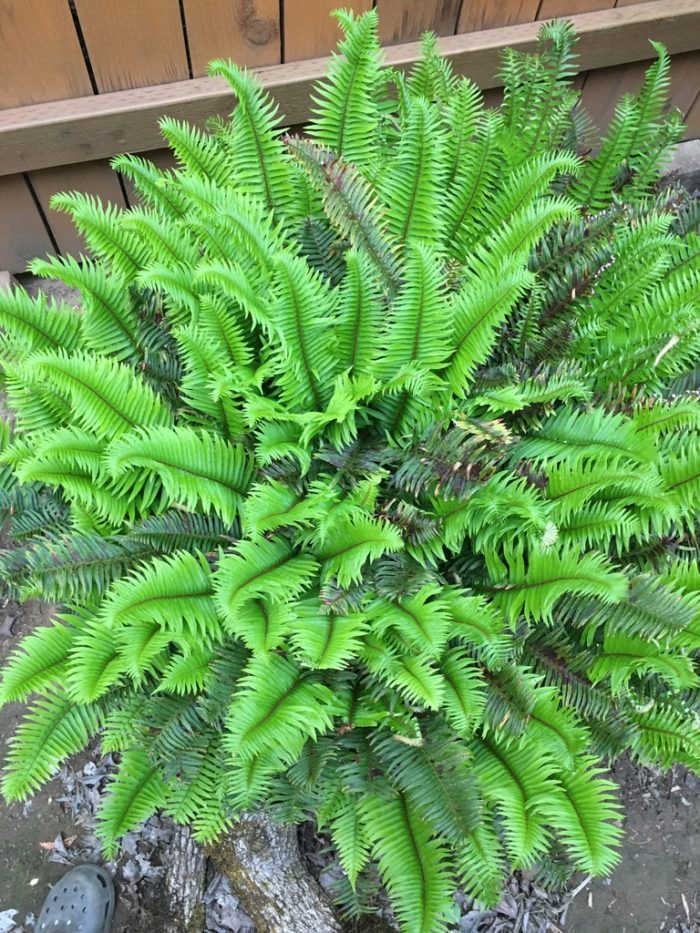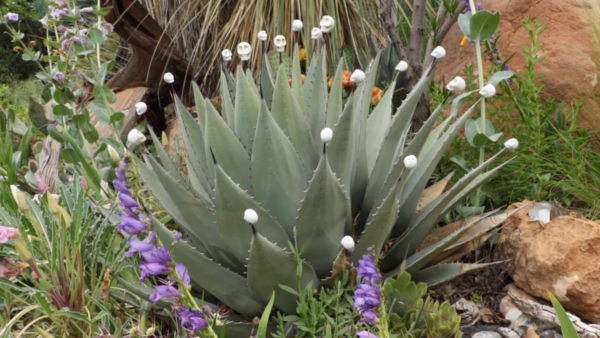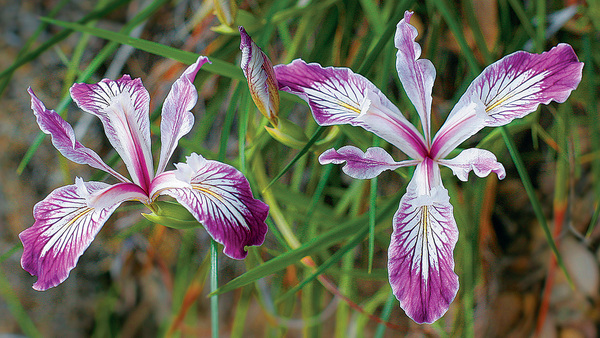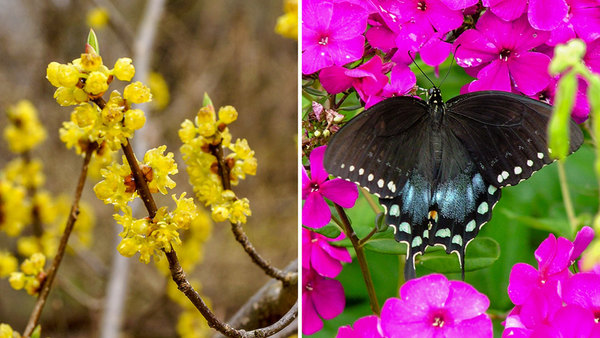My name is Karli Del Biondo, and I live in Milwaukie, Oregon, which is part of the Willamette Valley. I am a cardiac nurse, native gardener, and blogger. (Check out her Instagram @beetles_and_bees). I have been gardening for more than twenty years and have always been a lover of the natural world. When my husband and I bought a 1960s house three years ago, I started gardening with plants native to my area. The property had several large conifers, including four Western red cedars, which are native to the Pacific Northwest. I started working to create a native understory, then slowly began adding in native perennials. My interest in native gardening came from a desire to support our local native pollinators and wildlife, which depend on native plants for survival. My native garden now contains over 100 species of plants native to the Portland and Clackamas County area, and provides habitat in a variety of ways for wildlife.
 Pictured here is our native Pacific ninebark, Physocarpus capitatus (Zones 4–8), which holds four-season interest and attracts a variety of native bees. The peeling bark (hence the name ninebark) is beautiful and most visible during winter. Many of our native birds take cover here. This was actually my very first native and is now over 10 years old.
Pictured here is our native Pacific ninebark, Physocarpus capitatus (Zones 4–8), which holds four-season interest and attracts a variety of native bees. The peeling bark (hence the name ninebark) is beautiful and most visible during winter. Many of our native birds take cover here. This was actually my very first native and is now over 10 years old.
 One way I am able to provide habitat is through the use of nurse logs, which play an important role in ecosystem processes, one of which is providing a place where our native cavity nesting bees (30% of our native bee population) can lay their eggs. They also look beautiful as part of the natural landscape. Many of my nurse logs have licorice ferns and perennial natives such as candyflower (Claytonia sibirica, Zones 3–7), which are often seen growing on top or inside of nurse logs.
One way I am able to provide habitat is through the use of nurse logs, which play an important role in ecosystem processes, one of which is providing a place where our native cavity nesting bees (30% of our native bee population) can lay their eggs. They also look beautiful as part of the natural landscape. Many of my nurse logs have licorice ferns and perennial natives such as candyflower (Claytonia sibirica, Zones 3–7), which are often seen growing on top or inside of nurse logs.
Recently, a house in the neighborhood was “flipped,” and part of that process unfortunately included bulldozing the front yard, which had 50-year-old sword ferns (
Polystichum munitum,
Zones 3–8), to replace with lawn. We were able to rescue these beautiful native sword ferns (fifteen in total!) and incorporate them into our native landscape. After spending a year stunted, they have come back this year in their former glory. I like to think the elderly woman who used to live in the house where they originated would be happy if she knew they are still being lovingly cared for in a nearby garden, providing much-needed habitat for overwintering pollinators and wildlife. As an evergreen, they never grow old, they look beautiful year-round, and they love the acidic soil beneath our conifers.

Physocarpus capitatus
, which has these beautiful white clusters of blooms in spring (it was in full bloom on Mother’s Day). We observed close to 10 native bee species this year on our Pacific ninebark alone!
For the shadier areas of our native garden, there are many beautiful natives from which to choose. Pictured here is our native oxalis (
Oxalis oregana,
Zones 6–9), which is mixing well with native lady fern (Athyrium filix-femina,
Zones 4–8).
Native bumblebee on common snowberry (
Symphoricarpos albus,
Zones 3–7). Our queen bumblebees need overwintering sites like brush piles in the garden, as well as early-blooming natives like this one, to support them nutritionally once they emerge from hibernation in late winter or early spring. If there’s a place in your garden where you can leave a brush pile, our overwintering pollinators and other wildlife will find it beneficial.
Here is our beautiful native red-twig dogwood (
Cornus sericea
, Zones 3–7) which is a delight no matter what the season, and probably one of my favorites. This one is almost 15 years old (we brought it with us when we moved). I love it so much that I have planted several more on our property! Spectacular fall color gives way to stunning red twigs over winter, then beautiful green leaves emerge in spring, followed shortly by clusters of white flowers and white berries, which our native birds love to eat. This one is easy to propagate by hardwood cuttings or by seed, which I often do for friends and neighbors.
Native Oregon grape (
Mahonia aquifolium
, Zones 5–8), our state flower, is an evergreen with bright yellow flowers emerging in late February or early March. The “grapes” are somewhat bitter when eaten raw, but you can make lovely Oregon grape jelly, tincture, or infused simple syrup to mix with tonic water on a hot summer day. Native birds such as towhees, robins, sparrows, and waxwings love the berries. This plant is lovely year-round and is beneficial to wildlife and pollinators.
Native gardening has been rewarding on so many levels for me, including giving me a chance to connect daily with nature in my own yard. With its native plants, our yard is now attractive to many species that I was unable to observe when I was focused on exotics and other nonnatives. Our native species evolved in unique ways to support local ecosystems. Most native bees are specialists, requiring certain plants, or even one plant, to survive. Many natives serve as host plants for specific butterfly species, such as the monarch butterfly, for which common milkweed is a host. What we plant in our gardens matters, and yard by yard, we can help restore some of the habitat that was lost when neighborhoods and cities were built.
Have a garden you’d like to share?
Have photos to share? We’d love to see your garden, a particular collection of plants you love, or a wonderful garden you had the chance to visit!
To submit, send 5-10 photos to gpod@taunton.com along with some information about the plants in the pictures and where you took the photos. We’d love to hear where you are located, how long you’ve been gardening, successes you are proud of, failures you learned from, hopes for the future, favorite plants, or funny stories from your garden.
If you want to send photos in separate emails to the GPOD email box that is just fine.
Have a mobile phone? Tag your photos on Facebook, Instagram or Twitter with #FineGardening!
You don’t have to be a professional garden photographer – check out our garden photography tips!
Do you receive the GPOD by email yet? Sign up here.
Fine Gardening Recommended Products
ARS Telescoping Long Reach Pruner
Fine Gardening receives a commission for items purchased through links on this site, including Amazon Associates and other affiliate advertising programs.
Telescopes from 4 to 7'. Cut and Hold (160) Blades. Drop forged blades for unsurpassed long lasting sharpness. Lightweight, 2.3 lbs., for continued use. Perfectly balanced for easy pruning.
Pruning Simplified: A Step-by-Step Guide to 50 Popular Trees and Shrubs
Fine Gardening receives a commission for items purchased through links on this site, including Amazon Associates and other affiliate advertising programs.
Pruning Simplified shows you exactly how to do it. This must-have guide offers expert advice on the best tools for the job, specific details on when to prune, and clear instructions on how to prune. Profiles of the 50 most popular trees and shrubs—including azaleas, camellias, clematis, hydrangeas, and more—include illustrated, easy-to-follow instructions that will ensure you make the right cut the first time.
The Nature of Oaks: The Rich Ecology of Our Most Essential Native Trees
Fine Gardening receives a commission for items purchased through links on this site, including Amazon Associates and other affiliate advertising programs.
The Nature of Oaks reveals what is going on in oak trees month by month, highlighting the seasonal cycles of life, death, and renewal. From woodpeckers who collect and store hundreds of acorns for sustenance to the beauty of jewel caterpillars, Doug Tallamy illuminates and celebrates the wonders that occur right in our own backyards. He also shares practical advice about how to plant and care for an oak, along with information about the best oak species for your area.

 Pictured here is our native Pacific ninebark, Physocarpus capitatus (Zones 4–8), which holds four-season interest and attracts a variety of native bees. The peeling bark (hence the name ninebark) is beautiful and most visible during winter. Many of our native birds take cover here. This was actually my very first native and is now over 10 years old.
Pictured here is our native Pacific ninebark, Physocarpus capitatus (Zones 4–8), which holds four-season interest and attracts a variety of native bees. The peeling bark (hence the name ninebark) is beautiful and most visible during winter. Many of our native birds take cover here. This was actually my very first native and is now over 10 years old. One way I am able to provide habitat is through the use of nurse logs, which play an important role in ecosystem processes, one of which is providing a place where our native cavity nesting bees (30% of our native bee population) can lay their eggs. They also look beautiful as part of the natural landscape. Many of my nurse logs have licorice ferns and perennial natives such as candyflower (Claytonia sibirica, Zones 3–7), which are often seen growing on top or inside of nurse logs.
One way I am able to provide habitat is through the use of nurse logs, which play an important role in ecosystem processes, one of which is providing a place where our native cavity nesting bees (30% of our native bee population) can lay their eggs. They also look beautiful as part of the natural landscape. Many of my nurse logs have licorice ferns and perennial natives such as candyflower (Claytonia sibirica, Zones 3–7), which are often seen growing on top or inside of nurse logs.


























Comments
These are all quite enjoyable photos, many showcasing unfamiliar plant. Educational! And 15 of those gorgeous sword ferns has me hoping you'll submit more photos showing broader views of your garden beds and these great plants in context. Thanks so much, Karli!
Hey there! Thank you for your positive comments! I am hoping the garden will be ready for broader views in the next year or two. It's still on the young side, so right now broader views don't do it justice. We are also working on hard-scaping, which will complement the native plants well. Follow along on my native gardening journey on Instagram--I would love to connect there! --Karli P.S. I love the sword ferns--they look lovely just about anywhere, and do well beneath our Western red cedars--overall our soil is acidic d/t six large conifers on our property.
Thank you SO much for focusing on natives! I am trying to do that in my yard as well. It is encouraging that garden centers are increasing their offerings of native plants. I am still eliminating the non-natives that I bought and planted in years past. I send you continued good garden fortune!
Once I got started on native gardening and saw first-hand the positive impact it had on wildlife, there was no going back for me. Each year, I end up eliminating a few more non-natives. I'm down to only a few now. Here in Oregon, we have beautiful natives to choose from, and a variety of nurseries that only care native plants. The local soil and water conservation district was extremely helpful in connecting me with resources, and we have a local Backyard Habitat program as well. I'm so happy to hear you also have discovered the joy of native gardening! :) --Karli
You seem very knowledgeable, Karli, with a natural gift for sharing information. You could tell me your technique to propagate our red twig dogwood with hardwood cuttings. When do you do it?
I often use red twig dogwood in winter pots. I just cut stems and stick them in the soil. Even with our Wisconsin winters, by spring probably a quarter of those have rooted and leaf out. I've planted those and they do fine. I'm sure there is an optimal time but just dumb luck has worked for me. :-)
Thanks so much, Chris. Ha, I'm a big fan of "dumb luck" and serendipity.
Honestly, with red-twig dogwood, Douglas spirea, and Pacific ninebark, you could get away with sticking them straight into the ground without the rooting hormone--they are very easily propagated via live stakes! --Karli
On my Instagram highlight "Garden Projects" I show you how I propagated live stakes last fall. It's the best time of year to do it. Snip hardwood cuttings in the fall, dip in growth hormone, then place upright into small pots. Leave them for the fall/winter. By Spring, you will see small roots starting to extend, and they are ready for planting or giving away to others. Best propagating technique is by seed to allow for diversity, so you can dry out the seed from the berries, cold stratify (maybe best to place in a refrigerator, as we had a mild winter this past year here in Oregon, and many of my seeds outdoors weren't cold enough to germinate, but it depends on where you live), then plant in Spring.
Thank you also for your sweet compliment--it give me confidence to continue trying to make videos. I am practicing on video skills at the moment, but it gets better with practice. I'm a much better writer than I am speaker! :)
Good luck with propagating your red-twig dogwood--it's one of the easiest natives to propagate via hardwood cuttings!
--Karli :)
So much I didn't know included in this post. Pics are wonderful!
Thank you so much! Douglas W. Tallamy's book "Nature's Best Hope" is excellent if you haven't read it! Together we can build Homegrown National Park--a new perspective on conversation and land restoration, and very inspiring as we work together to create native habitat corridors throughout urban landscapes, most of which is turf grass. Thank you for your sweet message. --Karli :)
So glad you could rescue all those gorgeous Sword Ferns from the bulldozer! They are so pretty.
Didn't know till you told me how Mahonia is good for those birds.
I've learned a lot from you, thanks for sharing your knowledge!
One of my favorite native gardening books is Eileen Stark's "Real Gardens Grow Natives". In her book, she describes the benefits to wildlife of plants native to the PNW, mostly west of the Cascades. Where are you located? --Karli
Its wonderful that you have plants that help the birds and bees. And what you do is Contagious. There will be others who want to following your lead when they see not only your plants but the wildlife they attract.
Alice
Ahh, thank you, Alice! It is contagious, which is how I got started--by walking by a yard in my neighborhood that had a Backyard Habitat sign--I thought, their yard is like going on a hike in the forest--I love it! So peaceful with wildlife. As to native gardening being contagious--this is one big reason I am converting my front yard to habitat with native plants, utilizing educational signs for people to read as they pass by. Most people do not utilize their front yards, and part of it, maybe all of it, could easily be converted to native gardening habitat. Here is one sign that my friend in Nebraska, Dr. Tyler Moore, has produced to benefit a local prairie non-profit.
https://www.instagram.com/p/CCnCpR0B390/?utm_source=ig_web_copy_link
Info on how to order this sign is in my post.
Thank you so much for your positive comment! Look forward to seeing what others do with their habitat gardens!
--Karli
Wonderful post and pictures. Your attention to detail and to the interconnectedness of things in the garden convince me that you are also an excellent nurse. Thank you for this post and for your service as a nurse.
I agree with everything cheryl_c said.
:-)
Thank you, Cynthia! :)
You're the first person who has said this--thank you so much from the bottom of my heart. I do care about all living things from insects to human beings. Thank you so much for your heartfelt words. xo Karli
Karli, I aspire to have such a wonderful garden as yours. I have been planting natives in my CA garden and have most of the same varieties as you, but they are no where as established. Thanks for the tip about making a simple syrup with the Oregon grapes. It is not even 7:00 am and I am thinking about ways to use that in a cocktail.
There are several species native to my area that extend all the way down into California! I love seeing native gardens in other areas across the US, and really the world. My husband is Australian, and when I travel there, I am fascinated by the native flora and fauna. If you don't end up using some of your Oregon grapes for simple syrup, the birds will eat them up quickly! :)
Thank you so much for this inspiring post! I have been incorporating more and more native plants into my garden here, and also providing shelter for pollinators. It's disheartening though to see how many people have insecticides sprayed indiscriminately to "get rid of bugs" not even thinking that most are beneficial to us and our environment. I love the story of rescuing the ferns - when we lived in NJ, I rescued several plants that had been torn out and left at the curb like trash. 2 rhododendrons in particular - after I replanted them, pruned and cared for them, they became beautiful and bloomed profusely. The guy who tore them out told me later he wished he had asked me how to care for them instead of trashing them!
Very interesting story! People only know what they know at the time. One difficult thing for me is living in a neighborhood where a neighbor may decide to utilize a pesticide that may harm the very pollinators I am working to support! Another reason I have my pesticide-free garden sign in the front yard. Hoping it will at least encourage people to stop and think. Bugs is such an over-arching term, too, not taking into account the biodiversity.
What natives are you planting? Where are you located? I find this fascinating. :)
The nurse log concept is new to me--thank you. I have planted up rotting stumps in a similar way, but why not add some to my Michigan wildlife-friendly place?
Re: The nurse log concept is new to me
Same here!
They support a number of wildlife, including native bees that are cavity nesters. Also improve diversity of soil organisms, and provide a surface for other plants (like our native licorice ferns) to grow. On a hike yesterday, I saw many plants, including new trees growing out of nurse logs.
I think planting snags is a great idea--I would love to do that as well. Most of our logs came from a diseased birch tree we removed on our property--the others are oak from a mature white oak that unfortunately the local electric company heavily pruned. The sign read "Free firewood"--all I saw was nurse logs! They were also covered with licorice ferns and native moss.
Thank you Karli. You are a true native ecology hero! And your yard is beautiful. We have many of the same natives here in Western WA and on our property. Some others I enjoy are the native Spirea douglasii, Oceanspray (Holodiscus discolor), evergreen huckleberry (Vaccinium ovatum), and of course, Pacific dogwood (Cornus nuttallii). And there are so many more. Love what you have done with your garden.
You are too kind! I would love to pursue further education in ecology and conservation--maybe once the kids are on their way to college! Love that you are in Western Washington--would love to connect with you on my IG page! I have several other people on IG that I am connected with in Western WA. I have 12 evergreen huckleberry plants (Vaccinium ovatum), as well as the others that you mentioned. I saw black huckleberry (Vaccinium Membranaceum) up around Lost Lake on Mt. Hood yesterday--do you have that species in your garden? I'm thinking of adding it in. Thank you for your comment--it is inspiring to me and means a lot! :) --Karli
Great photos and such knowledge! I love to see native plant gardens, especially ones from other parts of the country (I'm in the Midwest). The idea of nurse logs is not new to me but I suspect they are much more common in some of the northwest ecosystems than in the rest of the country.
Great point--I will have to check in with my friend in Nebraska. I imagine much of the midwest is prairies and grasslands. Anywhere there are trees, however, I'm sure nurse logs are an important part of the ecosystem, though I am still learning about the midwest. Every area has its own local wildlife with different needs and adaptations. Thank you for your comment! :) --Karli
It seems everyone has already said the things that came to me as I was viewing your photos, so all I can add is a "bravo" for being such an ecologically concerned gardener. You're doing a wonderful job!
You are so kind--thank you so much. Benjamin Vogt wrote a beautiful book called "A New Garden Ethic: Cultivating Defiant Compassion for an Uncertain Future", and I think ethics in gardening is so important, but what inspires me more than anything is bringing conservation principles into my own yard. Native gardening is fascinating to me, sparking my curiosity about Nature daily as our garden continues to attract a variety of species. The more biodiversity in the garden, the healthier it will be! Almost weekly, I encounter a new species in our garden that I haven't seen before. I am keeping a list of species I am able to identify, and the list is always growing! We are also conserving water by planting natives that are adapted to our area (an added bonus!). Thank you so much for your kind post! Are you on the Oregon coast? --Karli
Log in or create an account to post a comment.
Sign up Log in